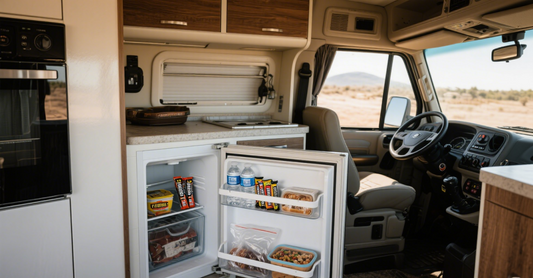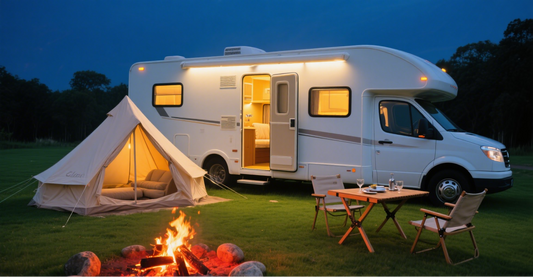What Size Lithium Battery For RV?
When outfitting your RV for off-grid adventures or full-time living, choosing the right battery size is one of the most important decisions you'll make. As more RV owners switch from traditional lead acid or AGM batteries to lithium RV batteries, understanding how to size your battery system properly ensures dependable power for all your essentials from lighting and refrigeration to running your air conditioner.
This guide breaks down everything you need to know about selecting the correct lithium battery size for your RV, based on your usage, rig type, and energy needs.


What is a Deep Cycle RV Lithium Battery?
A LiFePO4 battery, a type of deep cycle RV battery, is designed to deliver steady power over extended periods, making it bestfor RV applications.
Unlike traditional lead-acid batteries, LiFePO4 batteries can be discharged up to 80-90% of their capacity without damage, offering more usable energy for camper deep cycle battery needs, such as powering lights, refrigerators, or an air conditioner. Their lightweight construction and compact size make them suitable for motorhome batteries, fitting seamlessly into various RV battery compartments.
Why Lithium RV Batteries Are the Best Choice
In recent years, lithium, especially LiFePO4 batteries, has emerged as the go-to chemistry for RVers due to its safety, longevity, and consistent performance. Compared to lead acid batteries or even AGM battery types, lithium offers several compelling advantages:
- Consistent Power Supply: They maintain stable voltage, reliably powering multiple RV systems, including lights, water pumps, and high-energy appliances like an air conditioner.
- Higher usable capacity: Lithium batteries support up to 100% Depth of Discharge (DoD), allowing you to use nearly the full rated capacity.
- Longer lifespan: Many lithium RV batteries can handle over 3,000-5,000 deep cycles with minimal capacity loss.
- Lighter weight: Lithium options can weigh 50% less than similar-capacity lead acid units, and they simplify installation in RV battery compartments.
- Faster charging: When used with an appropriate charge controller, lithium batteries recharge more quickly and efficiently.
- Enhanced Safety: A built-in Battery Management System (BMS) protects against overcharging, over-discharging, overcurrent, and thermal runaway, ensuring safe operation in RVs.
- Off-Grid Reliability: Perfect for boondocking, they provide dependable power for extended periods without external sources.
How to Calculate the Right Lithium Battery Size for Your RV
Before choosing a battery, assess how much power you actually use on a daily basis. This will help you determine the required amp hours (Ah), the key unit for battery sizing.
Step 1: Estimate Daily Power Consumption
List out all the 12V and 120V appliances you intend to power, along with their average daily runtime.
| Appliance | Power (W) | Hours/Day | Energy Use (Wh/Day) |
|---|---|---|---|
| LED Lights (6x) | 60W | 5 hours | 300Wh |
| RV Fridge | 150W | 8 hours | 1200Wh |
| Water Pump | 100W | 0.5 hour | 50Wh |
| Phone Charging (2x) | 10W | 3 hours | 60Wh |
| Laptop Charging | 60W | 2 hours | 120Wh |
| Air Conditioner (12V DC) | 700W | 1 hour | 700Wh |
| Total Daily Energy | 2,430Wh |
Step 2: Convert to Amp Hours
Since most camper deep cycle battery systems are 12V:
2,430 Wh ÷ 12V = 202.5 Ah per day
To support a full day of off-grid use (with reserve), you'd need a 12V 200Ah lithium battery or two 12V 100Ah lithium batteries in parallel. You can also use the Temgo Lithium RV Battery Calculator to calculate how many Ah of a 12V lithium battery you need by entering your power requirements into the rated value.
Tip: Add a 15-20% buffer to account for inverter loss, wire resistance, and efficiency losses.
RV Battery Size Chart: Common Lithium Battery Sizes and Applications
Choosing the right RV battery size depends on your power needs and the physical space in your RV's battery compartment.
Although lithium batteries don't strictly follow BCI group sizes, many are designed to fit in standard compartments like Group 24 or Group 31. Here's how different sizes compare by capacity and usage:
| Battery Size | Approx. Dimensions (L×W×H) | Typical Capacity (Ah) | Common Use Case |
|---|---|---|---|
| Group 24 | 10.25×6.8×8.9 in | 100Ah | Weekend campers, basic lights, fans |
| Group 27 | 12.1×6.8×8.9 in | 125Ah | Medium-sized RVs, fridge, water pump |
| Group 31 | 13×6.8×9.4 in | 150–200Ah | Large RVs, AC units, off-grid setups |
| Custom Lithium Banks | Varies | 200–600+ Ah | Full-time RV living, solar + inverter setups |
Note: While these sizes reference lead acid standards, many 12V lithium RV batteries use modular cases that may vary. Always verify rv battery dimensions before purchase.
Choosing the Best Battery Capacity for Your RV Setup
Here's a quick reference for matching battery size to typical travel styles:
| RV Usage Type | Recommended Battery Size | Notes |
|---|---|---|
| Weekend Trips (Basic Use) | 100Ah lithium battery (Group 24) | Lighting, phones, water pump |
| Moderate Off Grid (Solar) | 200Ah lithium or 2x100Ah units | Fridge, fans, limited AC use |
| Full-Time Travel Living | 300–600Ah total capacity | AC, induction cooktops, large inverters |
| Solar-Powered Systems | Must match solar charge rate | Include solar input/output & charge controller |
12V vs. 24V Systems: Which Voltage is Right for You?
Most RVs use 12V deep cycle RV battery systems. However, switching to 24V offers efficiency advantages:
| Voltage | Pros | Considerations |
|---|---|---|
| 12V | Universal compatibility, easy to expand | Higher current = thicker cables |
| 24V | Lower current, better for large systems | Requires 24V inverter and components |
If you're driving a small to mid-size camper or travel trailer, 12V 100Ah or 12V 200Ah is typically enough. Use 24V only if you're running high-load appliances with large battery banks.
About Battery Configuration: Series vs. Parallel
How you connect your batteries determines your final system voltage and capacity:
- Parallel (Same Voltage, More Capacity):
2× 12V 100Ah batteries = 12V 200Ah
- Series (Higher Voltage, Same Capacity):
2× 12V 100Ah batteries = 24V 100Ah
Note: Never mix battery brands, ages, or capacities in the same series or parallel bank to avoid imbalance and safety risks.
Comparing LiFePO4 Batteries to Other Deep Cycle RV Batteries
To help you make an informed choice, here's a comparison of LiFePO4 batteries with other deep-cycle RV battery types for a better understanding:
LiFePO4 Batteries
- Pros: 3,000-5,000 cycles, lightweight (e.g., 25 lbs for Group 31 vs. 60 lbs for lead-acid), 2-3x faster charging (2-4 hours vs. 8-10 hours for lead-acid), maintenance-free, eco-friendly (no toxic heavy metals, recyclable), compatible with solar charge systems.
- Cons: Higher upfront cost, requires a lithium-compatible charge controller.
Lead-Acid Batteries (Flooded, AGM, Gel)
- Pros: Lower initial cost, widely available.
- Cons: 200-500 cycles, heavier (60-80 lbs for Group 31), slower charging, maintenance required for flooded types.
Comparing the key battery performance characteristics above, lithium-ion batteries offer superior durability and efficiency, providing long-term value for your outdoor adventures and offsetting their initial cost by reducing replacement and maintenance costs.
Installation and Maintenance Tips for Lithium RV Batteries
Proper installation and maintenance ensure optimal performance and longevity for your LiFePO4 battery, These practices ensure safe, efficient, and hassle-free operation, enhancing your RV camping experience.
Installation
- Please refer to the RV battery dimensions in the size chart and confirm that the battery will fit your RV battery compartment when purchasing.
- Use a lithium-compatible charge controller to prevent overcharging and ensure safe operation.
- Install with 10-12 AWG wiring for 12V 100Ah batteries (or 8 AWG for higher capacities like 12V 300Ah) and include a 100-150A fuse to protect against overcurrent.
- Ensure adequate ventilation to dissipate heat, as LiFePO4 batteries generate warmth during charging.
Maintenance
- Store in a cool, dry environment (32°F to 113°F) to preserve battery health and avoid capacity loss.
- Monitor battery status via BMS apps or LCD screens to track voltage and health.
- Avoid full discharges to maximize cycle life, though LiFePO4 batteries tolerate deeper discharges better than AGM batteries.
- Solar Integration: Pair with a lithium-compatible charge controller to optimize solar charge efficiency, ensuring reliable off-grid performance.
Conclusion: Power Your RV with Temgo LiFePO4 Batteries
Choosing the right lithium RV battery size ensures reliable power for your RV adventures, whether powering lights, a refrigerator, or an air conditioner off-grid. By calculating your power needs and using the RV battery size chart, you can select from Group 24, Group 27 or Group 31options to match your RVs requirements.
Whether you're an occasional weekender or a full-time RVer, Temgo Battery offers a range of LiFePO4 RV battery options tailored for dependable off-grid power. Temgo designs 12V battery solutions to fit common Group 24 and Group 31 compartments, making upgrades simple and stress-free.
If you looking for the best deep cycle battery for RV use? Explore Temgo's lithium RV battery and find the perfect fit for your travel needs.


